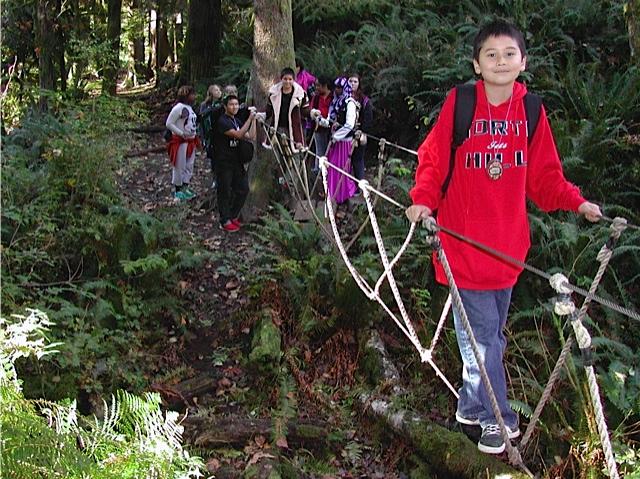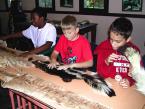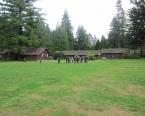Camp Waskowitz gets a makeover
There are lots of challenging outdoor activities at Camp Waskowitz, such as crossing a rope bridge.
Mon, 10/06/2014
by Ken Robinson
Editor
(Editor's disclaimer: I spend five days at Camp Waskowitz in 1956 as a sixth grader at Beverly Park Elementary. At the camp, I learned about how to determined the age of trees, the different types of conifers in the Northwest, to identify various plants in the understory of the forest and what it is like to sleep in a dorm with a bunch of other sixth graders as the first time away from home. I asked got scolded by one of the adult kitchen staff for tossing a dish towel over my shoulder while waiting for a wet pot to come my way for drying when I was on KP duty.)
If you went to school in the Highline District in the sixth grade, you probably went to Camp Waskowitz.
And it is also likely you have strong memories of visiting this quintessential Northwest place near North Bend that has been a treasure of the district since 1947.
Last weekend, the 372-acre camp got a makeover at the hands of NAOIP, the Commercial Real Estate Development Association. The group. some 300 strong, re-stained cabins, the council hall and lookout tower, relocated a large deck the other side of the coil hall, refurbished benches and picnic tables by the riverside amphitheater, repaired trails and installed gates and constructed a 150-square foot greenhouse to grow gtree seedlings.
Comprised of architects, civil engineers, landscape architects and construction companies, NAOIP also did a lot of weeding under the guidance of camp director Roberta McFarland.
"Their board looks for a project every year. They said they would like to come out. Many of them are saying "I went there as a sixth grader," McFarland said.
Over the years, roofs have been replaced, foundations fixed, earthquake measure have been taken, sprinkler systems put in and the buildings brought up to code.
Two-hundred students at a time can visit the camp. One-hundred sixty fifth and sixth graders and 25-30 high school leaders are there with staff and teachers. The camp operates year round, McFarland said, but is leased to different organizations. Soccer camps, Childrens Hospital, the Snoqualmie Tribe and other groups pay a fee that supports the districts mission.
Camp Waskowitz began as a CCC camp during World War II and was surplussed when the war ended. Some private investors bought it. Among them were some University of Washington football players including Fritz Waskowitz, captain of the team. Waskowitz was a fighter pilot killed at Guadalcanal in 1942. The group named the camp for him.
Roberta McFarland was working for the Houston School District in 1997. She was looking for a beautiful place to raise her child. She learned about and opening at Waskowitz and has been it's enthusiastic director every since.
"What's beautiful and what attracted me is students can come here in the fourth grade and they come back in the sixth grade and then come back as high school students--leaders--and it becomes their retreat, their place of peace. They go right back into the routines of how we do things. This is their home away from home.
There is a Living History program for fourth graders--a day program--panning for gold, using a crosscut saw, studying a native village, coal mining, a feel for logging and a feel for building a log cabin as Lewis and Clark might have done," McFarland said. When these students return as sixth graders for a longer stay, they are already familiar with the camp.
At any one time, their might be a mix of students from different schools at the camp. "They are randomly placed at different tables during meals and in the dorms. In the dorms, we blend different schools but have kids from their school there too. During the day, they are with their home school."
While Highline Public Schools owns and operates Camp Waskowitz, many other schools and groups across the state use the facility each year.
It is a state and national historic preservation site and one of only two CCC camps in the U.S. with all of the original buildings still standing.
Camp Waskowtiz includes four large dorms and cabins, a dining hall, barn, council hall, education center, administration buildings, and other structures. In addition to the buildings, there are miles of trails on either side of the Snoqualmie River.





